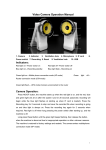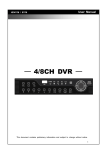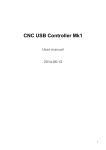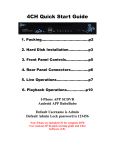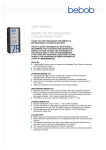Download EH6000H series
Transcript
EH6000H series EH6108H+/EH6216H+ Quick User Guide COPYRIGHT COPYRIGHT © 2011 AVer Information Inc. All rights reserved. No part of this document may be reproduced or transmitted in any form, or by any means without the prior written permission of AVer Information Inc. AVer Information Inc. reserves the rights to modify its models, including their characteristics, specifications, accessories and any other information stated herein without notice. The official printout of any information shall prevail should there be any discrepancy between the information contained herein and the information contained in that printout. TRADEMARKS “AVer” is a trademark owned by AVer Information Inc. Other trademarks used herein for description purpose only belong to each of their companies. NOTICE SPECIFICATIONS ARE SUBJECT TO CHANGE WITHOUT PRIOR NOTICE. THE INFORMATION CONTAINED HEREIN IS TO BE CONSIDERED FOR REFERENCE ONLY. WARNING TO REDUCE RISK OF FIRE OR ELECTRIC SHOCK. DO NOT EXPOSE THIS APPLIANCE TO RAIN OR MOISTURE. WARRANTY VOID FOR ANY UNAUTHORIZED PRODUCT MODIFICATION. INFORMATION For more information, please refer to the user manual in the software CD. QUICK USER GUIDE I. Package Contents EH6108H + (1) (2) (4) (3) (5) - (6) (7) (8) (9) If there is any damage, shortage or inappropriate item in the package contents, please contact with local dealer EH6108H+ has 2 models; one is come with DVD-ROM and another one is come with HDD tray. (1) EH6108H+ DVR unit (2) Optical USB mouse (3) Quick Installation Guide (4) Software CD (Manual is included) (5) Screws for internal HDD installation (6) Power adaptor (7) Power Cord (*The power cord may vary according to the local electricity system.) (8) SATA cables (9) Audio cable (Red cable: 8CH audio in/White cable: 1CH audio out/Black cable: 1CH MIC in) 1 EH6216H + (1) (2) (4) (3) (5) (6) (7) (8) (9) - If there is any damage, shortage or inappropriate item in the package contents, please contact with local dealer EH6216H+ has 2 models; one is come with DVD-ROM and another one is come with HDD tray. (1) EH6216H+ DVR unit (2) Optical USB mouse (3) Quick Installation Guide (4) Software CD (Manual is included) (5) Screws for internal HDD installation (6) Power adaptor (7) Power Cord (*The power cord may vary according to the local electricity system.) (8) SATA cables (9) Audio cable (Red cable: 16CH audio in/White cable: 1CH audio out/Black cable: 1CH MIC in) Optional Accessories SATA cable hard disk installation Remote controller IR extended cable DVI cable for Loop out Rack ears 2 QUICK USER GUIDE II. Hardware Installation A. Install the hard disk For hard disk spec, please referring to http://surveillance.aver.com/download-center → Embedded Hybrid DVR/NVR → EH6000H series → Hardware Recommendations Follow the illustrated instructions below to install the hard disk: 1. Loosen all screws(2 side and back) and push 2. Loosen the screws of holder in order to take the cover backward and lift out the hard disk rack. 3. Loosen all the screws of hard disk plate. 4. The hard disk plate can be installed 3 hard disks. User can choose the position and place the hard disk on it. 3 5. Turn the plate and hard disk over carefully and screw the hard disk on the plate. If hard disk cannot match to the screw hole, then, you may adjust the hard disk position to match the screw hole. 6. Plug the SATA cable into SATA connector on the PC board. [Note] 1. SATA 5 is for DVD player. 2. SATA 4 is for e-SATA interface 3. 1st HDD is suggested to install on SATA 6. 4. The number of SATA connector is displayed nearby SATA connector. 7. Plug the power cable and SATA cable into 8. hard disk. And then, screw the plate inside the DVR unit. User can leave un-plug the SATA cable on the left side HDD for screwing plate inside the DVR more easily later. 4 Plug the SATA cable into the left side hard disk. QUICK USER GUIDE 9. Screw the holder on the DVR unit. 10. 11. You may now connect all the cables and power on the DVR unit. 5 Push the cover forward and secure the cover B. Device Connection Pen drive and external hard disk must be FAT32 format. i All connected devices have their own power supply are necessary. EH6108H+ The back panel of the DVR unit, user can connect up to 8 cameras in combination of analog and IP camera. The DVR unit also can connect 16 sensor devices, 4 alarm devices, and output video to a TV or CRT/LCD monitor. Follow the illustration below to make the connection: For backup recorded video, plugging the pen drive or external hard disk through USB port that are located at front panel of DVR unit, and then, use the bundled software enables user to transfer, playback and segment the video. Follow the illustration below to make the connection: 6 QUICK USER GUIDE EH6216H+ The back panel of the DVR unit, user can connect up to 16 cameras in combination of analog and IP camera. The DVR unit also can connect 16 sensor devices, 4 alarm devices, and output video to a CRT/LCD monitor. Follow the illustration below to make the connection: For backup recorded video, plugging the pen drive or external hard disk through USB port that are located at front panel of DVR unit, and then, use the bundled software enables user to transfer, playback and segment the video. Follow the illustration below to make the connection: 7 III. Using DVR System A. Way to Operate DVR There are three ways can be managed the DVR unit: 1. Using mouse and keyboard Connecting the mouse and keyboard through USB interface, user can easily to manage the DVR unit. For the first time using DVR unit, mouse and keyboard is the best way to set up all DVR relevant configurations. 2. Using Remote Controller(Optional accessory) After DVR unit has been setup, user can use remote control to preview, playback, backup, reset alarm, output video and so on functions. 3. Using Front Panel buttons(EH6108H+ and EH6216H+ only) It’s an optional way to operate DVR unit. Front panel button function acts as same as remote controller. For the first time using DVR unit, using mouse and keyboard to setup all configurations. B. First Time Using DVR Unit 1. Connect the mouse and keyboard to DVR unit(through USB interface) 2. Power on the DVR unit. 3. For security purpose, the DVR system would require you to enter User ID and Password before it can be accessed. When the Authorization dialog box appears, enter the ID (admin) and Password (admin). The admin account has full authority to configure and operate the DVR system. After login, the main GUI as following shown: 8 QUICK USER GUIDE 4. The hard disk must be formatted before user can use it with DVR unit. Following the below steps to format the hard disk. i - Before formatting hard disk, please stop all operations on DVR system. - While formatting hard disk, the CPU usage will be near to 100% and might slow down the DVR system response. a. Click Setup and enter the password b. Click System → Add c. Select the hard disk from device list, then click Format button to start formatting. d. When formatting is done, click OK. 5. Setup the date and time in order to have correct recording time and date. Following the below steps to setup date and time: a. Click Setup and enter the password b. Click System c. In Time section, click Setting button of System Time. d. Select the year, moth and date, then, adjust the time. e. Click OK to save the setting. 6. Connecting the camera. To connect analog camera: a. Plug the analog camera video cable into DVR unit. b. Click Setup and enter the password. c. Click Camera. d. Select camera type as Analog Camera. e. Then, mark Enable to enable the camera. f. Give a name of camera and enter short description. g. Adjust the bright, contrast, hue, and saturation of camera. h. Finally, click OK. To connect IP camera: a. Click Setup and enter the password. b. Click Camera. c. Select the camera type as IP Camera. d. And then, enable the camera e. Click Add IPCam button. f. Select using Protocol or URL to connect the IP camera. If user chooses the Protocol, please select mode, video format, resolution, and channel of IP camera. If user chooses the URL, please enter the complete URL address of IP camera. g. Enter ID and password if IP camera’s access authority is required. h. Finally, click OK. DVR unit doesn’t supply the power to connected external device. 9 IV. Familiarizing the Buttons in Preview Mode Name (1) Exit (2) Split Screen Mode (3) Record (4) EMap (5) Network (6) Setup Function Reboot: To restart the DVR system. It is required to enter the password Power Off: To shut down the DVR system. It is required to enter the password Login: Using different ID to login to DVR system. Cancel: To return to DVR application. Select from 6 different split screen types to view all the camera, or one camera over the other or alongside on a single screen. It also allows you to switch and view different camera number. Start/stop video recording. Display the map in each area, and the location of camera/ sensor/ relay and the warning. Enable/disable remote system access. This feature allows you to access DVR server from a remote location via internet connection. Configure the system settings. (7) PTZ (8) Preview (9) Playback (10) Status bar Access PTZ control panel. Switch to Preview mode. This allows you to view live camera display. Switch to Playback mode. This allows you to view the recorded video file. (11) Camera ID Show the number of cameras that are being viewed. When you are in single screen mode, click the camera ID number to switch and view other camera. Display the current date, time, hard disk free space, and system temperature. 10 QUICK USER GUIDE Name (12) Snapshot (13) Event log (14) AutoScan (15) Full screen Function Capture and save the screen shot in *.jpg format. Show the record of activities that take place in the system. Start/Stop video screen cycle switch. View in full screen. To return, press the right button of the mouse or ESC on the keyboard or click the arrow icon. Click it to exit full screen mode (16) Alarm (17) Virtual Keyboard When you switch to full screen in multiple-screen mode, Left click to toggle to only display one of the video in the multiple-screen mode or all. Alert and display warning info. Administrator and user level both can reset alarm status. Click to enable virtual keyboard. 11 V. Familiarizing the Buttons in Playback Mode Click Playback button at the lower right corner of Preview UI to switch to Playback mode. Name (1) Split Screen Mode (2) Progress bar (3) Hour Buttons Function Select from 6 different split screen type to playback the recorded video file of all the camera, or one camera over the other or alongside on a single screen. Show the progress of the file being played. You may move the bar to seek at any location of the track. Select and click to playback the recorded video file on the specific time frame. The Hour buttons represent the time in 24-hour clock. The blue bar on top of the hour button indicates that there is a recorded video file on that period of time. While the red bar indicates that you are currently viewing the recorded video file. (4) Playback Control Buttons Begin: Move at the beginning of the recorded video file. Previous: Go back to the previous frame. Slower: Play the recorded video file at the reduce speed from 64x, 32x, 16x, 8x, 4x, 2x, 1x, 1/2x, 1/4x. Rewind: Wind back the recorded video file. Pause: Briefly stop playing the recorded video file. Play: Play the recorded video file. Faster: Play the recorded video file at the speed of 2X, 4X, 8X, 16X, 32X, or 64X. 12 QUICK USER GUIDE Name (4) Playback Control Buttons Function Next: Go to the next frame. End: Go to the end of the recorded video file. Select the date on the calendar and the time from 00 to 23 to where to start playing the recorded video file. (5) Date The numbers from 00 to 23 represent the time in 24-hour clock. The numbers from 01 to 16 represent the camera ID. The blue colored column indicates that there is a recorded video file on that period of time. While the red colored column indicates on where to start playing the recorded video file. (6) Preview Switch to Preview mode. (7) Playback Switch to Playback mode to view the recorded video file. (8) Status bar Display the recorded date, time and play speed. (9) Camera ID Show the number of cameras that are being viewed. When you are in single screen mode, click the camera ID number to switch and view other camera. Export includes Snapshot, Output Video Clip, and Backup function. Snapshot: Capture and save the screen shot in *.jpg format. Output Video Clip: Save the segmented file in *.dvr format to external USB storage device. Backup: Save the playback file to USB device or DVD disk (10) Export (11) Segment Keep a portion of the recorded video. 1. Use the Playback Control buttons or drag the bar on the playback progress bar and pause on where you want to start the cut. Then, click Segment to set the begin mark. 2. Use the Playback Control buttons or drag the bar on the playback progress bar and pause on where you want to end the cut. Then, click Segment to set the end mark. To cancel segmentation or set the segment marks from the start, click Segment button again. 3. Click Export button → Output Video Clip to save the video segment to the USB storage device. (12) Full screen View in full screen. To return, press the right button of the mouse or ESC on the keyboard or click the arrow icon on screen. When you switch to full screen in multiple-screen mode, Left click to toggle to only display one of the video in the multiple-screen mode or all. (13) Event log Show the record of activities that take place in the system. To filter the records, select and click the option button to only display Event, System, Operation, Network or All. 13 Name (14) Bookmark (15) Visual Search Function Mark a reference point when reviewing the recorded video file to which you may return for later reference. 1. Click Bookmark button 2. In the Bookmark dialog box, you may do the following: - Add to create the new reference mark in the bookmark list. - Edit to change the mark description. - Delete to remove the selected reference mark in the list. - Delete All to remove all the reference marks in the list. - Exit to close Bookmark dialog box. 3. Select and click one in the bookmark list to review the file. Search from a specific camera by Date, Hour, Minute, 10 Seconds and Second. 1. Click Visual Search. 2. In the Visual Search Setting dialog box, select the Camera number and the date. Then click OK. 3. When a series of frames appear by date, click on the frame to display another series of frames and search by every Hour of that date, every Minutes of that hour, and every Seconds of that minute. Using and to go previous and next page of screen page. To go back previous time section (hour, minute, or second), click . To close event search, click . Click to select different date of video for visual search. 4. On the time second screen, click the channel and playback button will appear. Click playback button to playback the selected channel video frame. 14 QUICK USER GUIDE Name (16) Find Next (17) Event Search (18) De-interlace Function Search for the next event or changes in the motion detector frame. You can use this when you are using Event Search function. Search from the recorded activities that were recorded in event log (i.e., Sensor, Motion, Video Loss). To enhance the video quality. Set the de-interlace mode to #1, if you are capturing motionless picture and #2, if it captures lots of movement. 15 P/N: 300AF2X9-DP5 Oct. 2011
























